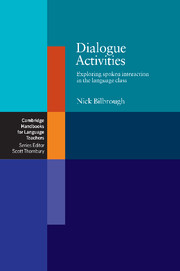Book contents
- Frontmatter
- Contents
- Thanks and acknowledgements
- Introduction
- 1 Understanding
- 2 Analysing
- 3 Reproducing and reconstructing
- 4 Memorising
- 5 Rehearsing and performing
- 6 Co-constructing
- 7 Creating and personalising
- 8 Communicating
- 9 Dialogue as learning
- Dialogue Bank A From the film Mulholland Drive
- Dialogue Bank B Authentic snippets
- Dialogue Bank C Snippets from fairy tales
- Dialogue Bank D Lame jokes
- Dialogue Bank E Situational dialogues
- Dialogue Bank F ‘Dating Agency’ from the comedy series Little Britain
- Further reading and resources
- Index
- Frontmatter
- Contents
- Thanks and acknowledgements
- Introduction
- 1 Understanding
- 2 Analysing
- 3 Reproducing and reconstructing
- 4 Memorising
- 5 Rehearsing and performing
- 6 Co-constructing
- 7 Creating and personalising
- 8 Communicating
- 9 Dialogue as learning
- Dialogue Bank A From the film Mulholland Drive
- Dialogue Bank B Authentic snippets
- Dialogue Bank C Snippets from fairy tales
- Dialogue Bank D Lame jokes
- Dialogue Bank E Situational dialogues
- Dialogue Bank F ‘Dating Agency’ from the comedy series Little Britain
- Further reading and resources
- Index
Summary
The ability to use language to communicate is something which requires practice. Since dialogue provides the interactive format on which all real communication depends, it is the ideal medium in which communicative language practice can occur.
Activities in previous chapters which have focused on production of language have tended to be interactive, but not necessarily communicative. There is a distinction: in interactive activities, learners are asked to use language which has already been planned and processed, and they are therefore not required to modify their utterances based on what they hear the other person saying. In a communicative activity however, each utterance is contingent on what has gone before. That is, learners need to listen to what the other person is saying and respond accordingly. In theatrical terms this can be compared to the difference between rehearsing the lines of a script and taking part in an improvisation.
Of course it is not enough to simply listen to the other person. The speaker needs to understand the words they are using and the listener needs to understand what they are hearing, and it is this need for comprehension that holds the dialogue together. This applies as much to being able to activate a suitable chunk or grammar structure where it is needed, as it does to the ability to pronounce language items so that they are intelligible.
- Type
- Chapter
- Information
- Dialogue ActivitiesExploring Spoken Interaction in the Language Class, pp. 170 - 195Publisher: Cambridge University PressPrint publication year: 2007



